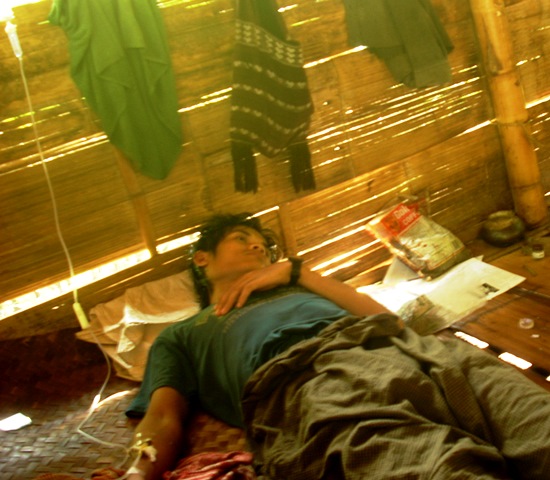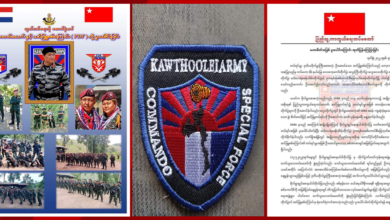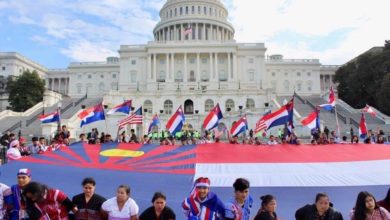Burma’s ‘Medical Refugees’ Find Health Care In Thailand

Despite ceasefires between armed ethnic groups and the government’s military, many people from Burma are continuing to cross the border into Thailand in order to seek health care that is inaccessible or unaffordable in their own country.
This has created a population of ‘medical refugees’, a phenomenon that has largely been ignored in the course of current discussions regarding Burma’s progress on the road to reform. Over the last two decades, a number of health clinics, nonprofit organizations, and Thai hospitals operating on the Thai-Burma border have attempted to fill the gap left by Burma’s inadequate health care sector, providing a range of services including direct medical care, training, and health education to people from Burma. However, international donors that have decided to withdraw funding from these organizations in the wake of Burma’s recent political reforms are ignoring the plight of Burma’s medical refugees and the fact that it will take decades to rebuild the country’s failed health care system.
Health care professionals, government officials, and patients currently living and working in Burma provide invaluable insight into the current state of the health care sector in Burma and the challenges that patients face in attempting to get treatment. Discussions with these groups highlight the true cost of health care for patients in need of complex medical treatment and the challenges Burma faces as it works to reform its health care system. However, while some physicians and hospital administrators are willing to talk honestly about the challenges facing Burma’s healthcare system, many more are hesitant to talk without official permission from Naypyidaw. Few physicians will stray from the official party line that “health care is free in government hospitals”. Assessing the reality underlying this official government position is a challenge.
USER PAYS
It is true that health care is nominally free in Burma’s government hospitals, but a closer look reveals a health care system is plagued by corruption, underpaid medical staff, and limited facilities and equipment. It is rare that any medical treatment is truly free of charge to patients and their families. Patients must pay out of pocket for every service imaginable, including medication, equipment, medical supplies, diagnostic tests, and even basic cleaning and sanitation services. For example, when one physician was asked about the cost of a routine surgery, the physician replied that while the surgery is free, the patient has to pay for all of the medication and supplies needed for the surgery and post-operative care. In addition to all of the out-of-pocket expenses born by patients, their families report that they are frequently asked to make a “donation” to hospital staff such as nurses and orderlies in order to receive quality care.
Doctors working in the government’s beleaguered hospitals have few answers when asked about the contradictions inherent in the concept of ‘free health care’ when contrasted against the reality of the significant out-of-pocket expenses paid by patients. There are no standardized billing or payment policies in place which means that health care professionals largely have discretion about how much to charge patients on a case-by-case basis. Physicians in Burma interviewed for this article acknowledged that some may doctors generate ‘business’ for themselves by referring patients from their own private clinics to local public hospitals and then informing hospital staff that the patient is under their personal care. This allows the doctor to have some control over what the patient pays, even at the “free” government hospital. One observer said that, “officially” patients do not have to pay for treatment, but “unofficially”, doctors might require patients to pay private clinic fees even to have surgeries done at the public hospital – if they want to have the surgery done by attentive staff in a timely manner.
In the face of all of the contradictions and confusion regarding billing practices in Burma, patients are explicit when commenting on their experiences – nothing is ‘free’ when it comes to health care in Burma. Patients must pay for everything out of pocket. Patients in need of a minor medical procedure such as dressing a wound must go out and purchase their own supplies, bringing gauze, iodine, and antibiotics to the physician on duty at the local hospital. Similarly, patients undergoing surgery will be given a list of the medication and supplies that will be needed for the operation and told they must purchase the items on their own in advance of the surgery. One woman whose daughter was hospitalized during a recent dengue fever outbreak said that her daughter had to stay overnight in the hospital for several nights while she was recovering from her illness. In addition to the cost of her daughter’s medication and medical supplies, she had to pay cleaning fees, pay fees for required blood work, and was also expected to make a “donation” to the hospital staff attending to her daughter. Another patient that sought treatment at Yangon General Hospital said that in addition to all of the standard fees for her care, she was told she would have to pay extra to stay in a shared room with several other patients. Otherwise, she would only be given a bed in a crowded hospital hallway.
A NEED FOR MORE DOCTORS AND EQUIPMENT
While the costs of health care in Burma remains a touchy subject, physicians and health care professionals are more willing to have open conversations about the resource constraints facing the Burmese health care system. There is near universal consensus that outside of Rangoon and Mandalay, there are few options for patients in need of advanced treatment, specialized testing, or surgical care. For patients without the money or means to go to Mandalay or Rangoon for treatment, local health care options are limited. A group of physicians in Mawlamyine (speaking on condition of anonymity) said that only simple pediatric surgeries can be done locally. For example, babies born with life-threatening gastrointestinal problems can undergo emergency surgery in Mawlamyine, but must then be referred to Mandalay or Rangoon for subsequent treatment including essential reconstruction surgery. Similarly, outside of Mandalay and RAngoon, there are limited facilities available to test and treat cardiac patients. Health care professionals in Karen State said that there is no echocardiogram machine available in Karen State. Patients in need of an echocardiogram must pay significantly higher fees at a private clinic in Mawlamyine or be referred to government hospitals in Mandalay or Rangoon.
Health care facilities are also limited in neighboring Mon State – the one CT machine in Mawlamyine is only available at a private clinic. Modest estimates are that a CT scan at a private clinic might cost anywhere from 80,000 to 120,000 kyat ($100 USD), depending on the type of CT. However, one patient (also speaking anonymously) said, in his experience, patients might be charged double that amount for a CT scan, depending on the clinic and part of the country where it was done. His observation illustrates the lack of a regulated pricing structure and how patients can rarely predict the costs of any given medical procedure. Recent estimates place the average annual per capita income in Burma between $200 and $230 making the cost of a CT scan completely out of reach for most people. Further, physicians in Mawlamyine noted that no MRI is available in either Mon State or Karen State and patients in need of an MRI must also travel to Mandalay or Rangoon.
In 2012, the World Bank reported that 67% of Burma’s population lived in rural areas making it difficult for many to access the advanced medical facilities, expertise, and equipment only available in larger cities like Mandalay or Rangoon. International reports estimate that up to 70% of the population in rural areas in Burma face significantly increased rates of poverty, making it impossible for many to pay for even basic health care expenses, let alone advanced investigative procedures such as a CT scan or an MRI. Despite the fact that the Burmese government raised health care expenditures to 3.9% of the government’s total budget in 2013, health care officials in Burma readily acknowledged that more investment is needed. However, on January 10th of this year, the Irrawaddy reported that Burma’s government is currently facing a budget deficit and does not plan to substantially boost its allocation of funds for the health care sector in the 2014 fiscal year.
In 2011, the most recent year for which data is available, the World Bank reported that Burma’s healthcare expenditure per capita was $23 U.S. dollars. By contrast, in Thailand, Burma’s neighbor, health expenditure per capita was $201 U.S. dollars. Health care professionals in Burma have also highlighted the resource constraints facing the country, noting that Burma does not currently have the means to meet the vast health care need. These resource constraints are best illustrated not only in the lack of specialized equipment and testing but in the limited numbers of specialists available throughout the country. Health care officials in Burma reported that there are limited numbers of specialists such as cardiologists and neurologists in the country and the majority of them only work in Rangoon or Mandalay. While the goal will be to expand such specialty services to all states and divisions, officials readily acknowledge that goal still remains far out of reach. Asia News summarized the challenges outlined by Burmese Health Minister, Dr. Phay Thet Khin. In a speech to the Senate in August 2013, he noted that there are only 15 neurologists and 12 neurosurgeons in the entire country. With the exception of Rangoon, Mandalay, and Naypyidaw, he said there are not enough specialists to serve the rest of the country. The minister stated that there is a shortage of urologists, gastroenterologists, and other specialists, with no hope for improvements in the short term since it takes more than 10 years for a doctor to specialize in a particular field.
SEEKING TREATMENT IN THAILAND
The impact of the shortage of medical specialists along with the lack of affordable options for people with complex medical conditions is illustrated in the case of Khine Yazar, a 13 year-old girl from Mon State with cardiac disease. When, at the age of 10, she developed symptoms including severe fatigue and difficulty breathing, her family took her to a local private clinic. There, the doctor examined her and after listening to her heart, told her family he suspected she had cardiac disease. He advised the family to take her to Rangoon for investigation and treatment as there were no medical facilities outside of Rangoon or Mandalay equipped to treat her should she need surgery. Worried about the potential expense of seeking treatment in Rangoon, her family decided to instead seek a second opinion at another private clinic in Thaton Township. The second doctor confirmed the diagnosis of cardiac disease, but he did not advise the family to take Khine Yazar to Rangoon for further treatment. Instead, he recommended her family take her to Thailand. He said he was doubtful that a pediatric cardiologist would be available to treat her in Rangoon. He further warned them that even if a cardiologist were available, the cost of the surgery would be more than the family could afford. Despite his advice, her family was reluctant to seek treatment in another country and decided instead to borrow money from relatives in order to take Khine Yazar for investigation and treatment at Rangoon’s Asia Royal Hospital. There, doctors again confirmed Khine Yazar’s diagnosis of cardiac disease and confirmed that she would in fact need surgery. However, the only cardiologist on staff was traveling abroad at the time and would not be available anytime soon to perform the surgery that she needed. Even if the cardiologist was available, the hospital staff confirmed that the cost of the surgery would be 10,000,000 kyat ($10,000 USD). Khine Yazar’s family had already borrowed money to cover the costs of the trip to Asia Royal Hospital. When accounting for the cost of transportation, consultation, and testing, the visit cost the family a total of 160,000 kyat ($165 USD). With an income of only 515,000 kyat ($515 USD) per year, her family could never hope to earn enough to cover the cost of her surgery. Recognizing the limitations of Burma’s health care system, hospital staff in Rangoon also advised Khine Yazar’s family that their best option was to seek treatment for her in Thailand. However, as they were already in debt for the costs of her initial investigation in Rangoon, they couldn’t imagine how they would be able to afford the cost of her treatment in Thailand. Out of options, the family returned home. When they heard about the Mae Tao Clinic, a free health clinic operating on the Thai-Burma border from a neighbor, they decided to seek treatment for Khine Yazar there in a last ditch effort to get her the help she needed. Medics at Mae Tao Clinic referred Khine Yazar to the Burma Children Medical Fund, a medical nonprofit organization also operating in Mae Sot. BCMF then facilitated and funded Khine Yazar’s cardiac surgery in Chiang Mai. However, without access to organizations like these, Khine Yazar’s family would have had few options for getting her treatment inside of Burma.
THE LEGACY OF CONFLICT
Burma’s long history of conflict and unrest adds another layer of complexity to the challenges Burma will face on the road to health care reform. Currently, Karen State has a population of 1.3 million people and is one of the most resource-starved regions in Burma. The ceasefire between the Karen National Union (KNU) and the Burmese government that has been in place since January 2012 has allowed some progress in addressing the region’s needs as the two entities have begun working together to address some of the more pressing health care issues. However, both sides must first seek the cooperation and approval of their respective leadership before moving forward.
An article published in Karen News, in April 2013, stated that officers from the Karen National Union (KNU) health department and Dr. Naing, the Karen State Health Director, met and agreed to cooperate to fight malaria, to prevent maternal deaths, and to work together to get recognition for Karen State health workers. While government officials agreed in principle to the planned cooperation, they said they first needed to report the issue back to Naypyidaw for approval. Similarly, KNU officials stated that they needed to draft a detailed health care plan and report back to the KNU’s Central Executive Committee for their approval.
Karen News noted that before the KNU and the Burmese government reached a cease-fire last year, Karen health workers were at risk of arrest and detention. In government designated ‘black zones’, ‘shoot on sight’ orders were in place, and health workers risked death for providing health service to Karen communities. As a recent article on Devex noted, conflict also complicates things for aid organizations interested in working in Burma. Aid groups often need permission from rebel groups to enter territories under their control. In addition to the KNU and the Burmese military, other ethnic armed groups operating in Karen State include the KNU/KNLA Peace Council, the Border Guard Force, and the Democratic Buddhist Karen Army (DKBA).
THE ROAD TO REFORM
One positive note in the face of the many challenges facing Burma is that recent political reforms in Burma have meant that there are more opportunities for NGOs and nonprofits to work inside Burma. Much of the focus among aid organizations has been on primary health care, providing basic medication, testing, and treatment for some of the most prevalent health problems in the country. One of Burma’s oldest donors was the “Three Diseases Fund” which was established in 2006 to reduce the burden of HIV/AIDS, tuberculosis, and malaria. Six bilateral donors as well as the European Commission, with a combined contribution of $140 million, supported the fund.
Today, conquering these diseases continues to be a primary focus of health care donors operating in Burma and the Global Fund is a major donor to Burma with continuing efforts to combat the three diseases. Aid organizations have also focused on providing basic health care to under served rural areas as well as reproductive, maternal, newborn and primary health care for children under 5 years of age, all essential areas to address for a country whose health care sector has languished under decades of conflict and military rule. Together with aid organizations working inside of the country, Burma is most definitely taking steps in the right direction when it comes to health care reform, but Burma watchers and public health experts point out that the task is monumental.
Despite this progress to address Burma’s primary health care needs, complex medical care remains a largely unaddressed area among aid organizations and there are only a handful of organizations helping patients who need surgery or advanced medical treatment. Options for those with complex medical conditions remain few and far between and many of these patients like Khine Yazar, are told outright by physicians in Burma that their best hope is to seek treatment in another country such as Thailand.
Many patients have exhausted their options in Burma before deciding to seek help from health organizations operating on the Thai-Burma border in a last ditch attempt to get treatment. Cutting funding to those organizations working to address the gap left by Burma’s struggling healthcare system is short sighted. It ignores the reality that while Burma is taking essential steps on the road to healthcare reform, patients must have access to essential medical services in the here and now. These services include life-saving surgery and complex medical treatment that, for the near future, continues to remain inaccessible and unaffordable to the majority of the population in Burma.
*Samantha Carter has worked as an auditor for the US Accountability Office and now works for Burma Children Medical Fund as a management and program analyst.




